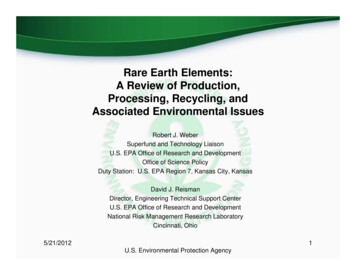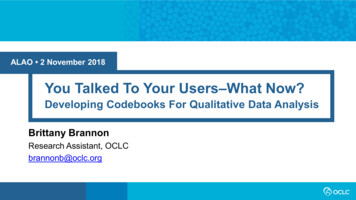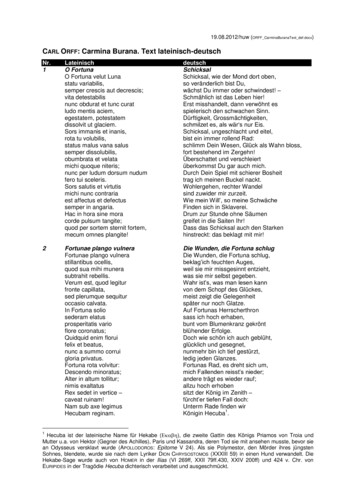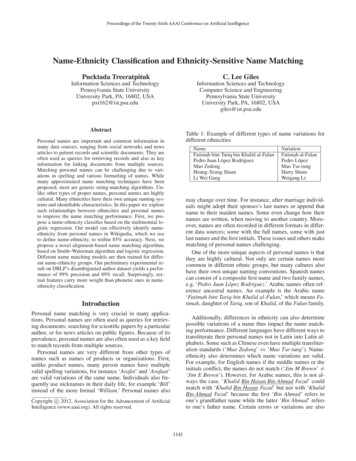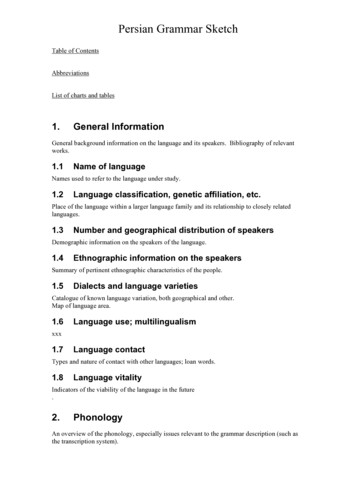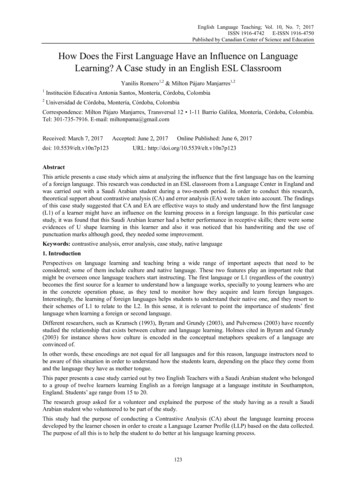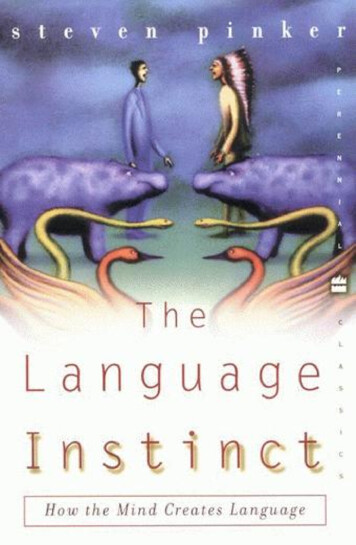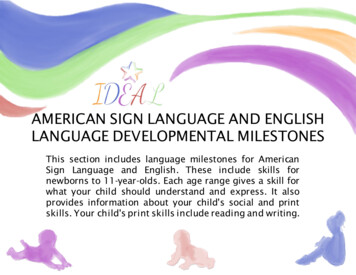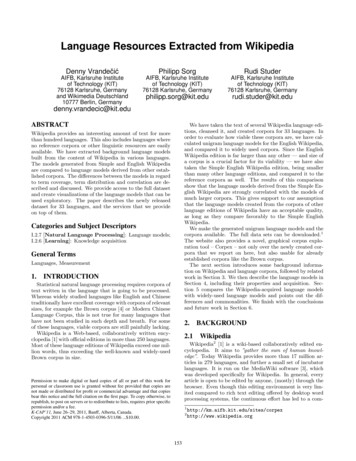
Transcription
Language Resources Extracted from WikipediaDenny VrandečićPhilipp SorgRudi StuderAIFB, Karlsruhe Instituteof Technology (KIT)76128 Karlsruhe, Germanyand Wikimedia Deutschland10777 Berlin, GermanyAIFB, Karlsruhe Instituteof Technology (KIT)76128 Karlsruhe, GermanyAIFB, Karlsruhe Instituteof Technology (KIT)76128 Karlsruhe, y.vrandecic@kit.eduABSTRACTWe have taken the text of several Wikipedia language editions, cleansed it, and created corpora for 33 languages. Inorder to evaluate how viable these corpora are, we have calculated unigram language models for the English Wikipedia,and compared it to widely used corpora. Since the EnglishWikipedia edition is far larger than any other — and size ofa corpus is a crucial factor for its viability — we have alsotaken the Simple English Wikipedia edition, being smallerthan many other language editions, and compared it to thereference corpora as well. The results of this comparisonshow that the language models derived from the Simple English Wikipedia are strongly correlated with the models ofmuch larger corpora. This gives support to our assumptionthat the language models created from the corpora of otherlanguage editions of Wikipedia have an acceptable quality,as long as they compare favorably to the Simple EnglishWikipedia.We make the generated unigram language models and thecorpora available. The full data sets can be downloaded.1The website also provides a novel, graphical corpus exploration tool – Corpex – not only over the newly created corpora that we report on here, but also usable for alreadyestablished corpora like the Brown corpus.The next section introduces some background information on Wikipedia and language corpora, followed by relatedwork in Section 3. We then describe the language models inSection 4, including their properties and acquisition. Section 5 compares the Wikipedia-acquired language modelswith widely-used language models and points out the differences and commonalities. We finish with the conclusionsand future work in Section 6.Wikipedia provides an interesting amount of text for morethan hundred languages. This also includes languages whereno reference corpora or other linguistic resources are easilyavailable. We have extracted background language modelsbuilt from the content of Wikipedia in various languages.The models generated from Simple and English Wikipediaare compared to language models derived from other established corpora. The differences between the models in regardto term coverage, term distribution and correlation are described and discussed. We provide access to the full datasetand create visualizations of the language models that can beused exploratory. The paper describes the newly releaseddataset for 33 languages, and the services that we provideon top of them.Categories and Subject DescriptorsI.2.7 [Natural Language Processing]: Language models;I.2.6 [Learning]: Knowledge acquisitionGeneral TermsLanguages, Measurement1.INTRODUCTIONStatistical natural language processing requires corpora oftext written in the language that is going to be processed.Whereas widely studied languages like English and Chinesetraditionally have excellent coverage with corpora of relevantsizes, for example the Brown corpus [4] or Modern ChineseLanguage Corpus, this is not true for many languages thathave not been studied in such depth and breath. For someof these languages, viable corpora are still painfully lacking.Wikipedia is a Web-based, collaboratively written encyclopedia [1] with official editions in more than 250 languages.Most of these language editions of Wikipedia exceed one million words, thus exceeding the well-known and widely-usedBrown corpus in size.2.2.1BACKGROUNDWikipediaWikipedia2 [1] is a wiki-based collaboratively edited encyclopedia. It aims to ”gather the sum of human knowledge”. Today Wikipedia provides more than 17 million articles in 279 languages, and further a small set of incubatorlanguages. It is run on the MediaWiki software [3], whichwas developed specifically for Wikipedia. In general, everyarticle is open to be edited by anyone, (mostly) through thebrowser. Even though this editing environment is very limited compared to rich text editing offered by desktop wordprocessing systems, the continuous effort has led to a com-Permission to make digital or hard copies of all or part of this work forpersonal or classroom use is granted without fee provided that copies arenot made or distributed for profit or commercial advantage and that copiesbear this notice and the full citation on the first page. To copy otherwise, torepublish, to post on servers or to redistribute to lists, requires prior specificpermission and/or a fee.K-CAP’11, June 26–29, 2011, Banff, Alberta, Canada.Copyright 2011 ACM 978-1-4503-0396-5/11/06 . ://www.wikipedia.org
petitive, and widely used, encyclopedia. The content is offered under a free license, which allows us to process the textand publish the resulting data.As stated, Wikipedia exists in many language editions.A special language edition is the so called Simple EnglishWikipedia.3 The goal of the Simple English Wikipedia isto provide an encyclopedic resource for users without a fullgrasp of the English language, e.g. children learning to readand write, or non-native speakers learning the language. Forour work this means that we have, besides the actual English Wikipedia,4 a second Wikipedia edition in the Englishlanguage that is much smaller in size.2.2CorpusBrownReutersTREC4 5JRC-Acquis 81841,163,635Table 1: Size of reference copora measured bynumber of documents, number of unique terms (ortypes) and total number of tokens.with little noise. Examples are news items or legislative documents. As these corpora mostly contain full sentences thatare grammatical correct, they are often used as representative corpora of the according languages. This is also a maindifference to automatically constructed corpora. Examplesfor such automatically constructed corpora are collectionsof Web documents that are crawled from the Web. In thesecorpora, the level of noise is much higher as they contain forexample syntax elements or misspelled terms.In our experiments, we use several English corpora forcomparison. We focus on English due to the availabilityof English corpora. In other language such as Croatian orSlovenian, only few corpora are freely available. In detail,we use the following corpora:Language CorporaLanguage corpora are the main tool of research in statistical natural language processing. They are big samples oftext that have the purpose to represent the usage of a specific natural language. Using a corpus in a specific language,different statistical characteristics of this language can bedefined. For example the distribution of terms is often usedin NLP applications. This distribution is either measuredindependently (unigram model) or in context of other terms(n-gram model).Language models extracted from these language corporaare used in all application that recognize or synthesize natural language. Examples for applications that recognize natural language are:Brown Corpus: [4] This corpus was published as a standard corpus of present-day edited American English.It has been manually tagged with part-of-speech information and has therefore often been used as trainingand testing corpus for deep analysis NLP applications.Speech Recognition: Language models are used to identify the text sequence with the highest probabilitymatching the speech input.Spell-checking: In the context of previous terms, the mostprobable spelling of terms is identified based on thelanguage model.Syntax Parser: Syntax parsers depend on language models to build syntax trees of natural language sentences.If annotated with part-of-speech tags, language corpora are also used as training data.TREC Text Research Collection V.4 5: 5 Thiscorpus was used in the ad-hoc retrieval challenge atTREC. It contains a compilation of documents fromthe Financial Times Limited, the Congressional Recordof the 103rd Congress, the Federal Register, the Foreign Broadcast Information Service, and the Los Angeles Times.The examples presented above describe applications oflanguage corpora to recognition tasks. Further, languagemodels are also applied in systems that synthesize text:Reuters Corpus (Volume 1): 6 Collection of news stories in the English language that has often been usedas real-world benchmarking corpus.Auto-completion: The term distribution encoded in language models can be used to auto-complete input ofusers. In many cases, these are language models optimized for a specific task, for example language modelsof queries in search systems. For auto-completion, often the context of previous terms is used to computethe probability of the next term.JRC-Acquis: 7 Legislative documents of the EuropeanUnion that are translated in many languages. Thiscorpus is often used as a parallel corpus, as the sentences are aligned across the translations.Table 1 contains statistics about the size of the presentedreference corpora in respect to the number of documents,unique terms and tokens.Machine Translation: Machine translation systems recognize text in one language and synthesize text in another language. To ensure grammatical correctness orat least readability of the synthesized text, languagemodels can be used to identify the most probable wordorder in the output sentences.3.Over the years, a number of corpora have been established. These corpora contain documents of high quality34RELATED WORKIn recent years, Wikipedia has often been used as languageresource. An example is presented by Tan and Peng [12].They use a Wikipedia based n-gram model for their approach to query segmentation. Using the model extracted5http://trec.nist.gov/data/docs g154
from the English Wikipedia, they achieve performance improvements of 24%. They therefore present a successful application of the language models derived from the EnglishWikipedia. In this paper we show that other language editions of Wikipedia can be exploited in the same way and aretherefore valuable resources for language models in variouslanguages.Exploiting the multilingual aspects of Wikipedia, different approaches have been suggested to use the Wikipediadatabase in different languages for multilingual InformationRetrieval (IR) [11, 10]. The language models presented inthis paper have no dependencies across languages. For eachlanguage, we suggest to exploit the according Wikipedia edition to build a language resource that is specific for this language. However, these resources could also be applied incross-lingual systems, as many of these systems also rely onlanguage-specific background models.Apart from Wikipedia, language corpora have also beenbuilt from other Web resources. Recently, a number of hugeWeb-based corpora have been made available by Google8and Microsoft.9 Baroni et al. [2] constructed large corporaof English, German and Italian Web documents that werealso annotated based on linguistic processing. Ghani et al.[5] proposed to use the Web to create language corpora forminority languages. By creating and adapting queries for Internet search engines, they collect documents with a broadtopic coverage. In this paper, we claim that the coverage isalready given by Wikipedia for many languages. We showthat Wikipedia based language models have similar properties than language models derived from traditionally usedcorpora. This is not known for the Web based corpora.Further, Wikipedia supports many more languages than theabove mentioned Web based resources. Finally, given thelower effort to access Wikipedia compared to crawling theWeb, we claim that using Wikipedia as a resource for language models is an appropriate choice in many applicationscenarios.There are other multilingual corpora that are not based onWeb documents. For example, Koehn [6] created a parallelcorpus of the proceedings of the European Parliament thatis mainly used to train machine translation systems. Thiscorpus is similar to the JRC-Acquis corpus used in our experiments. However, the results of our experiments supportthe conclusion that these corpora can not be used to buildrepresentative language models. A possible explanation isthat these multilingual corpora are much smaller comparedto the other resources and that they are often focused onspecific topic fields.The application of language models are manifold. A prominent example are retrieval models used in IR. Zhai andLafferty [13] suggest to use background language modelsfor smoothing. These models are based on a collection ofdatasets that also includes the TREC4 5 corpus. This motivates the comparison of the Wikipedia language modelsto this corpus presented in Section 5. Most of the relatedwork about the application of language models is based ontasks in English. The language models that we suggest inthis paper could be used to apply the same approaches invarious languages. The improvements achieved in specifictasks such as IR through the usage of background languagemodels, could then be replicated and verified in experimentsusing corpora in other languages than English as well.4.4.1THE LANGUAGE MODELSAcquistionArticles in Wikipedia are written using the MediaWikisyntax, a wiki syntax offering a flexible, but very messy mixof some HTML elements and some simple markup. Thereexists no proper formal definition for the MediaWiki syntax. It is hard to discern which parts of the source text ofan article is actual content, and which parts provide furtherfunctions, like navigation, images, layout, etc. This introduces a lot of noise to the text.We hav
that Wikipedia based language models have similar proper-ties than language models derived from traditionally used corpora. This is not known for the Web based corpora. Further, Wikipedia supports many more languages than the above mentioned Web based resources. Finally, given the lower e ort to access Wikipedia compared to crawling the 11 ()

